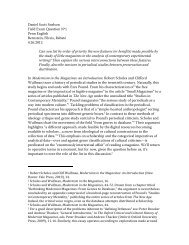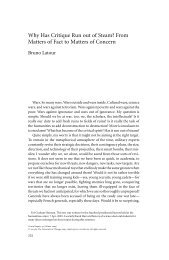The Exploit: A Theory of Networks - asounder
The Exploit: A Theory of Networks - asounder
The Exploit: A Theory of Networks - asounder
Create successful ePaper yourself
Turn your PDF publications into a flip-book with our unique Google optimized e-Paper software.
164 Appendix<br />
disidentify ENTITY<br />
removes all unique IDs, pr<strong>of</strong>ile data,<br />
and other quantitative identifiers<br />
for the specified entity<br />
drift ENTITY<br />
initiates for specified ENTITY an<br />
aimless wandering within or<br />
between hosts<br />
emp TIME after the number <strong>of</strong> seconds pro -<br />
vided by TIME, this function<br />
sends an electromagnetic pulse,<br />
neutral izing self and all machines<br />
within range<br />
envision an inductive function for articu la -<br />
tion <strong>of</strong> unknown future realities.<br />
Often used in conjunction with<br />
rebuild.<br />
exorcise USER<br />
fail FUNCTION<br />
frees TIME<br />
invert HEX<br />
jam NETWORK<br />
prohibits USER from accessing a<br />
given host. If USER is not specified,<br />
function stipulates that the host<br />
will run only when there are no<br />
users present.<br />
introduces logical fallacies into any<br />
other language method specified by<br />
FUNCTION<br />
frees the machine from operating<br />
by freezing it for the number <strong>of</strong><br />
seconds specified in TIME<br />
allows a machine to infect itself<br />
with malicious code specified in<br />
HEX by first sending that code<br />
across a network to other machines<br />
and then receiving it back in an<br />
altered form<br />
sends jamming signal to the<br />
specified NETWORK









